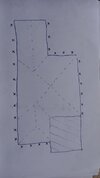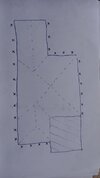You are using an out of date browser. It may not display this or other websites correctly.
You should upgrade or use an alternative browser.
You should upgrade or use an alternative browser.
Soffit Vents - too much ventilation?
- Thread starter berty3000
- Start date
Sponsored Links
The whole situation with insulation versus ventilation is a ridiculous farce. One minute the building regs say soffit vents are needed, then they don't, then they do again. Let's make our homes warmer with insulation and double glazed windows... oh no, now there's too much condensation! Let's add vents and open windows, making it colder again.
Might as well have left things as they were, unless there is some happy medium the average occupier can somehow figure out, despite the constantly changing daily conditions?
Might as well have left things as they were, unless there is some happy medium the average occupier can somehow figure out, despite the constantly changing daily conditions?
You're only venting the uninsulated loft, not the heated part of the house.
In the past you had draughty window frames, gaps under doors and open fireplaces. Damp wasn't an issue because you were either cold or were using stupid amounts of energy to heat the place. Energy was once much cheaper so most didn't care, so houses had heated fresh air in them.
Your flat roof should be vented, this ventilation usually flows to/from the pitched roof space.
In the past you had draughty window frames, gaps under doors and open fireplaces. Damp wasn't an issue because you were either cold or were using stupid amounts of energy to heat the place. Energy was once much cheaper so most didn't care, so houses had heated fresh air in them.
Your flat roof should be vented, this ventilation usually flows to/from the pitched roof space.
Nonsense.One minute the building regs say soffit vents are needed, then they don't, then they do again.
You are confused about keeping houses better insulated v's condensation build up. Insulating houses and ridding them of condensation, can exist together, without fuss. Condensation build-up is an idiosyncratic lifestyle issue and should be dealt with accordingly.
Sponsored Links
You're only venting the uninsulated loft, not the heated part of the house.
In the past you had draughty window frames, gaps under doors and open fireplaces. Damp wasn't an issue because you were either cold or were using stupid amounts of energy to heat the place. Energy was once much cheaper so most didn't care, so houses had heated fresh air in them.
Your flat roof should be vented, this ventilation usually flows to/from the pitched roof space.
Thanks for the reply.
So just to confirm, the main roof does have breathable membrane (vent 3 pro, BBA). I am going to check in the attic soon to see if there is dampness. I think what I found previously may have been to do with me leaving the loft cover off all day. If there's no obvious dampness, may not be need for further action.
Humidity in house tends to be just shy of 60% RH, although it seldom gets up up to 20 centigrade inside, so I don't think there's a damp issue within the living space. No mold or musty smells. I am also adding some trickle vents soon to the older UPVC windows to assist with ventilation, and will start using the heating more.
If I do find damp in the attic, then do I need ridge or tile vents? Are soffit vents sufficient on their own? As per the attached, the main roof is hipped with two lower pitch roofed outriggers. Then there is the flat roofed extension.
The problem with ventilating the flat roof is that I assume vents would be needed in the fascia along the side. However, I don't think there is much of a pathway for this air to reach the main roof space. Inside the main roof, chipboard stuff slopes down where the rubber membrane has been attached on the outside and the roofer filled between the joists with regular loft insulation. As I understand it, a 50mm head space would be needed above the insulation but I think he packed it quite tight. Am I screwed? The room below the flat roof is dry, and I have the vents above the sliding patio door permanently open.
I will go up in the loft at the weekend and get some photos and check out moisture levels. I will also feed my endoscope camera into the roof void of the extension to see if there's anything nasty going on.
Attachments
I have seen it suggested that the vents would cool the loft space and potentially make pipes more vulnerable to bursting. A lot of mine are lagged and covered in insulation. The mains water pipes only have insulation over them though.As they've said above you are talking about ventilating an unheated area so the vents will not contribute to heat loss in any meaningful way. Condensation will compromise the ability of the insulation to do its job.
A plumber I know says that when he goes to fix burst pipes in attics, damaged by the cold, that it doesn't tend to matter whether they are lagged or not. In his view it is more important to keep the heating on so the house is warm below. Which might suggest that insulation over the top is the main thing, combined with a warm house. Still, vents in the attic would still bring colder temperatures nearer pipes?
Of course it will be colder if ventilated.
Check if there's an issue first, worry about the detail later.
Check if there's an issue first, worry about the detail later.
Ok, so I went back up into the wretched attic earlier, contorted myself into all sorts of cramped situations, and had a really good look around with a very bright torch, and had a good feel of the materials up there. I also took my hygrometer up there.Of course it will be colder if ventilated.
Check if there's an issue first, worry about the detail later.
I attach photos.
The white breathable membrane appears clean and dry for the most part. Except for one side of the outrigger, which is located alongside the flat roofed extension. There are what look like damp patches along the membrane on that specific side, noting that there are no soffits on that side or air flow because of the extension.
However... those apparent damp patches didn't feel damp to the touch. They also appear on one long sheet of membrane. Could it be a coincidence that there just happened to be grease marks on that sheet? You will see the darker patches run in a line along the top edge of the sheet... is this a level where moisture is condensing, or just an edge where the roll of membrane was sat in grease before installation? That said, there are random, discrete darker patches further along on the same sheet as well - but are those indicative of condensation? Again, they didn't feel wet.
The timbers generally felt mostly dry, although there are stains in places. These, I suspect, are historic. The structure of the roof is 60 odd years old. I attach some photos. They look like they're from previous ingress rather than condensation. To the touch, they don't feel soaked or recently wet, despite all the rain recently. Just very faintly damp.
I could not smell any damp up there and didn't see any mold. Just the usual attic smell.
I wasn't able to too see or feel any damp around the perimeter of the flat roofed extension. I got my hand in there a bit. Difficult to be certain, and sometimes colder things can feel deceptively damp. But there was nothing setting alarm bells off, apart from the patches I've mentioned.
I attach photos for others to hopefully feedback on. Please note that it is a 1961 house and the old roof was very much at the end of its life when I got it all replaced in the spring. So if it doesn't look pretty in there or the timbers have marks on them, possible they're not recent.
The hygrometer read 79% RH and 12.3C by the time I was done up there. I was up there for nearly two hours and was sweating by the end so possibly contributed to humidity. Afterwards I put the hygrometer outside for a bit and the reading, after heavy rain had finished, was 83% and 6.6C.
So basically, the attic temperature is half way between the outside and the accommodation below.
Any feedback welcome.
Attachments
-
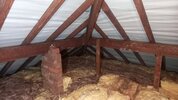 20231110_151726.jpg203.8 KB · Views: 72
20231110_151726.jpg203.8 KB · Views: 72 -
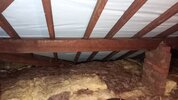 20231110_151735.jpg171.8 KB · Views: 70
20231110_151735.jpg171.8 KB · Views: 70 -
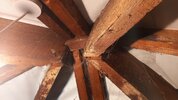 20231110_151743.jpg249.1 KB · Views: 68
20231110_151743.jpg249.1 KB · Views: 68 -
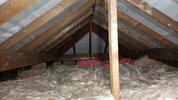 20231110_155324.jpg226.4 KB · Views: 67
20231110_155324.jpg226.4 KB · Views: 67 -
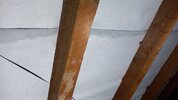 20231110_155638.jpg266.3 KB · Views: 65
20231110_155638.jpg266.3 KB · Views: 65 -
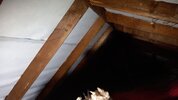 20231110_155700.jpg127 KB · Views: 70
20231110_155700.jpg127 KB · Views: 70 -
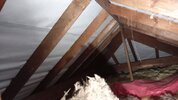 20231110_155807.jpg155.7 KB · Views: 66
20231110_155807.jpg155.7 KB · Views: 66 -
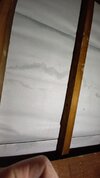 20231110_161512.jpg200.9 KB · Views: 69
20231110_161512.jpg200.9 KB · Views: 69 -
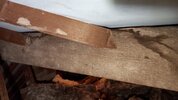 20231110_160240.jpg221.3 KB · Views: 73
20231110_160240.jpg221.3 KB · Views: 73 -
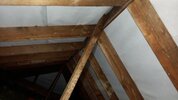 20231110_155333.jpg147.8 KB · Views: 75
20231110_155333.jpg147.8 KB · Views: 75
Last edited:
Have you got recessed spotlights anywhere?
Have you got recessed spotlights anywhere?
No... I do have some flat lights where the holes may need some silicone. I also have trunking in three rooms that radiator pipes run through from attic down to skirting board level. I have my suspicions about these as a route for humidity into the loft, although the openings inside the house are near ground level (I assume the warmer moisture laden air is higher up in each room).
How would you block off the bottoms of this trunking? Silicone will corrode the copper pipes.
The other thing I'm thinking is just to bite the bullet and install soffit vents at maybe one per metre. This would hopefully give some air movement and push factor to get humidity moving. Either through the soffit vents themselves or the breathable membrane.
What I'm not sure about is whether soffit vents are basically pointless without higher up vents as well, such as ridge vents? I read that one without the other doesn't do much. But maybe the membrane is a former of higher up vent?
The other issue is that it will be very difficult for me to ventilate the flat roof. Will putting soffit vents opposite this result in air blowing in from outside and then cause moisture problem on the flat roof side where those marks are already? Or will breathable membrane take care of this in addition to the rear soffit vents being along a different stretch? (See attached)
Attachments
I've fitted 40 soffit vents over the past few days, mostly at 500mm centres, but some a bit further apart.
I put a remote thermo hygrometer in the attic earlier today. Seems there has been quite a change in conditions since the vents have started having an effect.
Before, the readings up there on one occasion were 12.3C and 79%, which represents a dew point of nearly 9C. At that point in time the temperature up there was half way between the outside temperature and the temperature in the living space below 6 and 18 respectively).
The readings right now, after the soffit vents being installed are 7C and 80%. So a far lower dew point, more like 3.8C. The temperature up there is about the same as outside and the humidity is lower than outside. Meanwhile, the temperature below is over 19C and the heating turned off a few hours ago. So it seems that loft insulation is doing its job and the soffit vents have made it colder but also drier in the attic - the dewpoint is lower than both outside and in the home.
My question now is, should I also install the 30 lap vents I've bought? The "breathable" roofing membrane is quite tight so I'm not sure if they'll even fit, but my thinking is that they will complement the soffit vents if I install them higher up, ensuring air flow around the whole roof. Main concern is what if I'm installing too much ventilation? Is this possible? It is quite a bit colder up there now, basically the same as outside and I'm worried about freezing pipes in the coming months, although most of them are lagged where I could reach and, I think, all of them are under insulation, apart from some dead legs that stick up.
Thoughts?
I put a remote thermo hygrometer in the attic earlier today. Seems there has been quite a change in conditions since the vents have started having an effect.
Before, the readings up there on one occasion were 12.3C and 79%, which represents a dew point of nearly 9C. At that point in time the temperature up there was half way between the outside temperature and the temperature in the living space below 6 and 18 respectively).
The readings right now, after the soffit vents being installed are 7C and 80%. So a far lower dew point, more like 3.8C. The temperature up there is about the same as outside and the humidity is lower than outside. Meanwhile, the temperature below is over 19C and the heating turned off a few hours ago. So it seems that loft insulation is doing its job and the soffit vents have made it colder but also drier in the attic - the dewpoint is lower than both outside and in the home.
My question now is, should I also install the 30 lap vents I've bought? The "breathable" roofing membrane is quite tight so I'm not sure if they'll even fit, but my thinking is that they will complement the soffit vents if I install them higher up, ensuring air flow around the whole roof. Main concern is what if I'm installing too much ventilation? Is this possible? It is quite a bit colder up there now, basically the same as outside and I'm worried about freezing pipes in the coming months, although most of them are lagged where I could reach and, I think, all of them are under insulation, apart from some dead legs that stick up.
Thoughts?
See how it goes, if it's adequate then no need to go overboard.
Our loft has little ventilation, just 5 airbricks near the top of the walls at scattered points around the perimeter. Don't have an issue with condensation though, despite the old unbreathable roofing felt.
Our loft has little ventilation, just 5 airbricks near the top of the walls at scattered points around the perimeter. Don't have an issue with condensation though, despite the old unbreathable roofing felt.
It now seems that temperature is lower in the attic than outdoors, is this normal? A degree or two colder through the morning, now mostly caught up, perhaps because the heating is on. Also more humid than outdoors. Might be that the attic cools down and warms up more slowly than the outside variations, or there is dampness up there that still needs to clear... maybe more vents needed after all... thoughts?See how it goes, if it's adequate then no need to go overboard.
Our loft has little ventilation, just 5 airbricks near the top of the walls at scattered points around the perimeter. Don't have an issue with condensation though, despite the old unbreathable roofing felt.
Think you should stop thinking, and just see how it goes!
It will be colder than outside first thing, as it has thermal mass so will lag the rise in outdoor temperature. Also if you're measuring the outside temperature in sunlight then you're getting an aritificially high temperature. You need to measure in the shade.
Similarly it will be warmer than outside in the evening. All totally normal.
It will be colder than outside first thing, as it has thermal mass so will lag the rise in outdoor temperature. Also if you're measuring the outside temperature in sunlight then you're getting an aritificially high temperature. You need to measure in the shade.
Similarly it will be warmer than outside in the evening. All totally normal.
DIYnot Local
Staff member
If you need to find a tradesperson to get your job done, please try our local search below, or if you are doing it yourself you can find suppliers local to you.
Select the supplier or trade you require, enter your location to begin your search.
Please select a service and enter a location to continue...
Are you a trade or supplier? You can create your listing free at DIYnot Local
Sponsored Links
Similar threads
- Replies
- 2
- Views
- 519
- Replies
- 5
- Views
- 399


